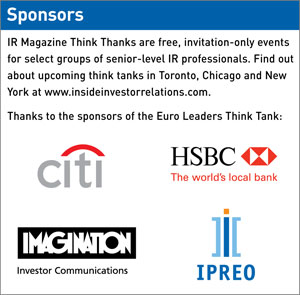What happens when you get the best IROs from across Europe into one room? Highlights from the IR Magazine Euro Leaders Think Tank 2011
It was clear at the last IR Magazine Euro Leaders Think Tank that IR in Europe has evolved into something more than a communications function or a financial role. It is now its own unique, sophisticated and structured discipline. At this gathering of around 60 of Europe’s best IR professionals, many of them in London to be honored that evening at the IR Magazine Europe Awards (see Kings and queens of Europe), IROs from different companies and different industries heard from experts in investment and market intelligence fields.
Mostly, however, they heard from each other. They heard, for example, from a German company that five years ago decided to double its US shareholder base from less than 10 percent, and today has nearly 20 percent held in the US. That clearly defined goal tied into similar ones for continental Europe, the UK and Asia. ‘Clear targets from an IR perspective for a global company,’ the IRO summed up.
Another pro, while eschewing set targeting milestones, has been focusing on Canada and Israel because his firm has competitors there. ‘We want to be in their territory, tackling investors that are already investing in their domestic markets,’ he said.
Several IR professionals described structured IR programs way beyond the cozy and reactive approach of old: ‘We’re always short of time so we intensively select which investors we see, and which ones we see with top management or only on an IR level.’
In that scenario, tier-one targets are visited by top management and an IR manager at least once (preferably twice) a year; tier two by top management and an IR manager once a year; and around 50 tier-three targets get ‘missionary’ visits by IROs. Another firm sees its top five shareholders four times a year with management; its next 45 twice a year; and the rest get seen only by IR.
Sell side in their sights
This tiered approach extends to sell-side analysts. One IRO admitted frankly that he no longer takes a democratic approach to the 40 or so analysts covering his firm: ‘We’re more discriminating than before. The ones with staying power get the most slots.’
Another groups his few dozen analysts into a top tier of global houses producing good research, a middle tier of more local houses that still do good research, and a bottom tier of smaller firms. This IRO added that he’s seen the top tier rise in importance because of better collaboration between big firm analysts and their equity sales and corporate access teams.
By contrast, a Nordic IRO said all two dozen or so analysts covering her company are producing good-quality research – but she considers carefully who she goes on roadshows with, and where. ‘I like to go to a city with a bank that has a local analyst,’ she said. ‘The next factor is the sales force, and how good its coverage is.’
Many IROs at the think tank talked longingly of tapping Asian capital markets but mostly agreed that while Asia is a fast-growing investor segment, it’s still a small one. ‘Asia is long term: start by identifying key players and building relationships with brokers to make sure you know where potential investment will come from,’ advised one targeting expert.
The subject of hedge funds came up a lot, but where previously they were eyed with suspicion, today they’re viewed with more equanimity. ‘They’re no longer a no-go area,’ said one IRO. ‘They often have a longer investment horizon, and many are long-only.’
A future think tank topic may be the growth of exchange-traded funds, now estimated to be worth $2.5 tn to $3 tn and challenging hedge funds. That means ‘an inevitable narrowing of the active investor base,’ one expert pointed out, ‘and presumably a risk-enhanced volatility among those active investors left. Plus, being an index constituent becomes more important than ever.’
Pro and con
A highlight of the think tank was a debate between a fund manager, arguing that analyzing macroeconomic factors is beyond the scope of IR, and an IRO who passionately believes the opposite.
‘I’m inundated with macroeconomic thought. The trouble is, most of it is complete rubbish,’ began Chris Bailey, a global equities portfolio manager with Close Asset Management. ‘When I meet management, I want to hear why your company is great, what market positions and competitive advantages you have, and why I should be buying your shares or holding onto them. I can get all the macroeconomic stuff elsewhere.’
Matt Hardwick, Cisco’s head of international IR, rebutted, noting that in IR magazine’s latest European awards survey, macro factors like country risk, forex and input costs are more critical to investment decisions than ever before. ‘They’re becoming an important part of equity valuation and investment theses,’ he stated. ‘Who do we see as an ideal investor? Someone who takes a long-term view of the stock and the industry we operate in – and macro analysis is part of that. I believe it encourages owners, not speculators.’
This article appeared in the September print edition of IR magazine.










